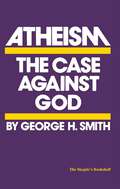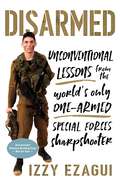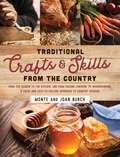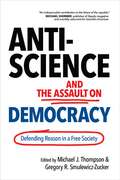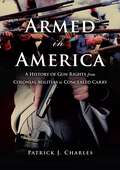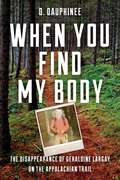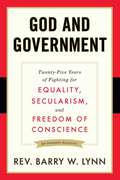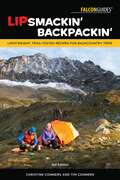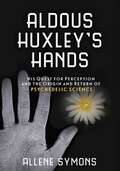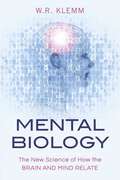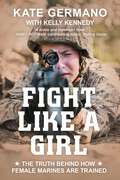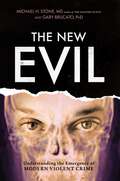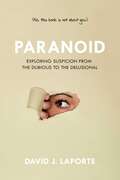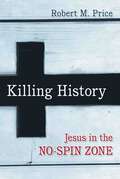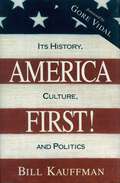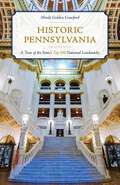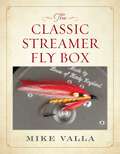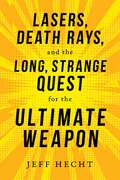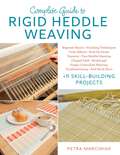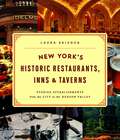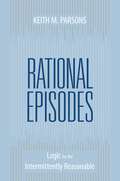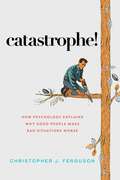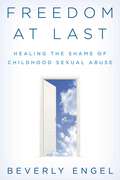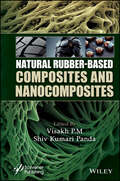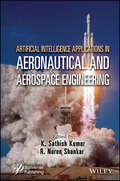- Table View
- List View
Atheism: The Case Against God
by George H. SmithGeorge H. Smith sets out to demolish what he considers the most widespread and destructive of all the myths devised by human beings - the concept of a supreme being. With painstaking scholarship and rigorous arguments, Mr. Smith examines, dissects, and refutes the myriad "proofs" offered by theists - sophisticated, professional theologians - as well as the average religious layman. He explores the historical and psychological havoc wrought by religion in general and concludes that religious belief cannot have any place in the life of modern, rational man. "It is not my purpose to convert people to atheism . . . (but to) demonstrate that the belief in God is irrational to the point of absurdity. If a person wishes to continue believing in a god, that is his prerogative, but he can no longer excuse his belief in the name of reason and moral necessity."
Disarmed: Unconventional Lessons from the World's Only One-Armed Special Forces Sharpshooter
by Izzy EzaguiThe inspiring story of a young American who volunteered to fight in the Israel Defense Forces, lost his arm in combat, and then returned to the battlefield. Combining refreshing candor with self-deprecating wit, this inspiring memoir will encourage readers to live up to their aspirations despite seemingly impossible odds. On January 8, 2009, Izzy Ezagui—an American who had enlisted in the Israel Defense Forces (IDF) at nineteen—lost his arm in a mortar attack on the border of the Gaza Strip. In this stirring and wryly humorous memoir, Izzy recounts his tortuous trek through rehabilitation to re-enlistment as a squad commander in the IDF. He became the world's only one-armed Special Forces sharpshooter. This isn't a typical war chronicle, full of macho bluster and the usual hero tropes. Izzy wrote this book with his fellow millennials in mind—not necessarily those with military ambitions, but everyone facing life's daily battles. His message is universal: if a self-described "nerd" and "one-armed basket case" like him can accomplish what he set his mind to, then anyone can become a hero in his or her own life. Growing up in a religious household in Miami, Izzy's early life was plagued by self-doubt, family drama, and (far too few) girl troubles. His search for direction eventually led him to that explosion on the Gaza border, changing his life forever. In the midst of disaster, Izzy discovered a deep well at his core, from which he could draw strength. Through his motivational speeches across the world, and now through this book, he encourages people to seek their own power, and to face whatever adversity life throws at them.
Traditional Crafts and Skills from the Country
by Monte Burch Joan BurchTime-honored practices for a more self-reliant and satisfying lifestyle.Ever have the urge to raise your own chickens, grind your own flour, or start your own compost pile? If any of these ideas sound appealing, this is the book for you.A growing number of people are intrigued by the "homesteader" experience and the idea of doing things themselves, whether they own a big spread in the wilderness or live on a small plot of land in the suburbs. Traditional Crafts and Skills from the Country presents the practical information necessary to become more self-reliant at home, pick up a new hobby, or even learn a skill that may provide a secondary income.The authors' crafts and skills include: beekeeping; raising sheep and goats; starting seeds; composting; felling trees; building split-rail fences; making soap and candles; drying and preserving foods; laying stone; making butter and cheese; reading the weather; and much more. From raising livestock to woodcrafting, from the garden to the kitchen, Monte and Joan Burch have a fresh and easy-to-follow approach to country wisdom that is sure to win over even the most die-hard city dweller.
Anti-Science and the Assault on Democracy: Defending Reason in a Free Society
by Michael J. Thompson and Gregory R. Smulewicz-ZuckerDefending the role that science must play in democratic society--science defined not just in terms of technology but as a way of approaching problems and viewing the world. In this collection of original essays, experts in political science, the hard sciences, philosophy, history, and other disciplines examine contemporary anti-science trends, and make a strong case that respect for science is essential for a healthy democracy. The editors note that a contradiction lies at the heart of modern society. On the one hand, we inhabit a world increasingly dominated by science and technology. On the other, opposition to science is prevalent in many forms--from arguments against the teaching of evolution and the denial of climate change to the promotion of alternative medicine and outlandish claims about the effects of vaccinations. Adding to this grass-roots hostility toward science are academics espousing postmodern relativism, which equates the methods of science with regimes of "power-knowledge." While these cultural trends are sometimes marketed in the name of "democratic pluralism," the contributors contend that such views are actually destructive of a broader culture appropriate for a democratic society. This is especially true when facts are degraded as "fake news" and scientists are dismissed as elitists. Rather than enhancing the capacity for rational debate and critical discourse, the authors view such anti-science stances on either the right or the left as a return to premodern forms of subservience to authority and an unwillingness to submit beliefs to rational scrutiny. Beyond critiquing attitudes hostile to science, the essays in this collection put forward a positive vision for how we might better articulate the relation between science and democracy and the benefits that accrue from cultivating this relationship.
Armed in America: A History of Gun Rights from Colonial Militias to Concealed Carry
by Patrick J. CharlesNOW WITH A NEW PREFACE THAT BRINGS THE FRAUGHT GUN-RIGHTS CONTROVERSY UP TO DATE This accessible legal history describes the way in which the Second Amendment was interpreted throughout most of American history and shows that today's gun-rights advocates have drastically departed from the long-held interpretation of the right to bear arms. This illuminating study traces the transformation of the right to arms from its inception in English and colonial American law to today's impassioned gun-control debate. As historian and legal scholar Patrick J. Charles shows, what the right to arms means to Americans, as well as what it legally protects, has changed drastically since its first appearance in the 1689 Declaration of Rights. Armed in America explores how and why the right to arms transformed at different points in history. The right was initially meant to serve as a parliamentary right of resistance, yet by the ratification of the Second Amendment in 1791 the right had become indispensably intertwined with civic republicanism. As the United States progressed into the 19th century the right continued to change--this time away from civic republicanism and towards the individual-right understanding that is known today, albeit with the important caveat that the right could be severely restricted by the government's police power. Throughout the 20th century this understanding of the right remained the predominant view. But working behind the scenes was the beginnings of the gun-rights movement--a movement that was started in the early 20th century through the collective efforts of sporting magazine editors and was eventually commandeered by the National Rifle Association to become the gun-rights movement known today. Now with a new preface that brings the fraught gun-rights controversy up to date, this book is an invaluable resource for readers looking to sort through the shrill rhetoric surrounding the current gun debate and arrive at an informed understanding of the legal and historical development of the right to arms.
When You Find My Body: The Disappearance of Geraldine Largay on the Appalachian Trail
by D. DauphineeWhen Geraldine &“Gerry&” Largay (AT trail name, Inchworm) first went missing on the Appalachian Trail in remote western Maine in 2013, the people of Maine were wrought with concern. When she was not found, the family, the wardens, and the Navy personnel who searched for her were devastated. The Maine Warden Service continued to follow leads for more than a year. They never completely gave up the search. Two years after her disappearance, her bones and scattered possessions were found by chance by two surveyors. She was on the U.S. Navy&’s SERE (Survival, Evasion, Resistance, and Escape) School land, about 2,100 feet from the Appalachian Trail.This book tells the story of events preceding Geraldine Largay&’s vanishing in July 2013, while hiking the Appalachian Trail in Maine, what caused her to go astray, and the massive search and rescue operation that followed. Her disappearance sparked the largest lost-person search in Maine history, which culminated in her being presumed dead. She was never again seen alive. The author was one of the hundreds of volunteers who searched for her. Gerry&’s story is one of heartbreak, most assuredly, but is also one of perseverance, determination, and faith. For her family and the searchers, especially the Maine Warden Service, it is also a story of grave sorrow.Marrying the joys and hardship of life in the outdoors, as well as exploring the search & rescue community, When You Find My Body examines dying with grace and dignity. There are lessons in the story, both large and small. Lessons that may well save lives in the future.
God and Government: Twenty-Five Years of Fighting for Equality, Secularism, and Freedom Of Conscience
by Barry W. LynnA central player in every major church-state-separation battle for decades, the Rev. Barry W. Lynn understands the complexities of this divisive issue like few others. As a long-time activist, a civil rights lawyer, and an ordained minister in the United Church of Christ, he offers a unique perspective and a wealth of experience on church-state controversies. In this lively book, he has compiled his writings from various sources to explore in depth the many ways religious extremists have attempted to erode individual liberties. The topics range from publicly-promoted prayer to efforts to undermine public education and replace it with taxpayer-subsidized vouchers for religious schools, interfering with end-of-life and reproductive rights, censorship, and belligerence directed against nonbelievers and minorities. Lynn concludes that the ultimate goal of these extremist forces-consisting mainly of the Protestant Religious Right and the Roman Catholic hierarchy-is the creation of a corporate theocracy, a decidedly undemocratic system of government in which nonconservative Christians, along with humanist, feminists, and the LGBTQ community, are relegated to second-class status in America.
Lipsmackin' Backpackin': Lightweight, Trail-Tested Recipes for Backcountry Trips
by Christine Conners Tim ConnersNot a fan of bland, boring, and lifeless meals after a hard day of backpacking? Neither are the Conners, which is why you'll find their new second edition packed full of even more tasty favorites from the trails! Completely revised and updated, this all-in-one food guide builds on the format pioneered by the original, providing clear and thorough at-home and on-trail preparation directions, nutrition and serving information, and the weight of each recipe, while adding a wealth of reference information and instructional material. Pacific Crest Pancakes, Jammin' Jambalaya, and Buried Forest Trail Fudge - it's in here!
Aldous Huxley's Hands: His Quest for Perception and the Origin and Return of Psychedelic Science
by Allene SymonsPsychedelics, neuroscience, and historical biography come together when a journalist finds a lost photograph of Aldous Huxley and uncovers a hidden side of the celebrated author of Brave New World and The Doors of Perception. Allene Symons had no inkling that Aldous Huxley was once a friend of her father's until the summer of 2001 when she discovered a box of her dad's old photographs. For years in the 1940s and '50s, her father had meticulously photographed human hands in the hope of developing a science of predicting human aptitudes and even mental illness. In the box, along with all the other hand images, was one with the name of Aldous Huxley on the back. How was it possible for two such unlikely people to cross paths--her aircraft-engineer father and the famous author? This question sparked a journalist's quest to understand what clearly seemed to be a little-known interest of Aldous Huxley. Through interviews, road trips, and family documents, the author reconstructs a time peaking in mid-1950s Los Angeles when Huxley experimented with psychedelic substances, ran afoul of gatekeepers, and advocated responsible use of such hallucinogens to treat mental illness as well as to achieve states of mind called mystical. Because the author's father had studied hundreds of hands, including those of schizophrenics, he was invited into Huxley's research and discussion circle. This intriguing narrative about the early psychedelic era throws new light on one of the 20th-century's foremost intellectuals, showing that his experiments in consciousness presaged pivotal scientific research underway today.
Mental Biology: The New Science of How the Brain and Mind Relate
by W. R. KlemmA leading neuroscientist offers the latest research and many new ideas on the connections between brain circuitry and conscious experience. How the mysterious three-pound organ in our heads creates the rich array of human mental experience, including the sense of self and consciousness, is one of the great challenges of 21st-century science. Veteran neuroscientist W. R. Klemm presents the latest research findings on this elusive brain-mind connection in a lucidly presented, accessible, and engaging narrative. The author focuses on how mind emerges from nerve-impulse patterns in the densely-packed neural circuits that make up most of the brain, suggesting that conscious mind can be viewed as a sort of neural-activity-based avatar. As an entity in its own right, mind on the conscious level can have significant independent action, shaping the brain that sustains it through its plans, goals, interests, and interactions with the world. Thus, in a very literal sense, we become what we think. Against researchers who argue that conscious mind is merely a passive observer and free will an illusion, the author presents evidence showing that mental creativity, freedom to act, and personal responsibility are very real. He also delves into the role of dream sleep in both animals and humans, and explains the brain-based differences between nonconscious, unconscious, and conscious minds. Written in a jargon-free style understandable to the lay reader, this is a fascinating synthesis of recent neuroscience and intriguing hypotheses.
Fight Like a Girl: The Truth Behind How Female Marines Are Trained
by Kelly Kennedy Kate GermanoOne woman's professional battle against systemic gender bias in the Marines and the lessons it holds for all of us. The Marine Corps continues to be the only service where men and women train separately in boot camp or basic training. This segregation negatively affects interaction with male marines later on, and, lower expectations of female recruits are actively maintained and encouraged. But Lieutenant Colonel Kate Germano arrived at the Fourth Recruit Training Battalion at Parris Island--which exclusively trains female recruits--convinced that if she expected more of the women just coming into Corps, she could raise historically low standards for female performance and make women better Marines. And, after one year, shooting qualifications of the women under her command equaled those of men, injuries had decreased, and unit morale had noticeably improved. Then the Marines fired her. This is the story of Germano's struggle to achieve equality of performance and opportunity for female Marines against an entrenched male-dominated status quo. It is also a universal tale of the effects of systemic gender bias. Germano charges that the men above her in the chain of command were too invested in perpetuating the subordinate role of women in the Corps to allow her to prove that the female Marine can be equal to her male counterpart. She notes that the Marine Corps' $35-million gender-integration study, which shows that all-male squads perform at a higher level than mixed male-female squads, flies in the face of the results she demonstrated with the all-female Fourth Battalion and raises questions about the Marine Corps' willingness to let women succeed. At a time when women are fighting sexism and systemic bias in many sectors of society, Germano's experience has wide-ranging implications and lessons--not just for the military but also for corporate America, the labor force, education, and government.
New Evil: Understanding the Emergence of Modern Violent Crime
by Michael E. Stone Gary Brucato PhDRevisiting Dr. Michael Stone's groundbreaking 22-level Gradations of Evil Scale, a hierarchy of evil behavior first introduced in the book The Anatomy of Evil, Stone and Dr. Gary Brucato, a fellow violence and serious psychopathology expert, here provide even more detail, using dozens of cases to exemplify the categories along the continuum. The New Evil also presents compelling evidence that, since a cultural tipping-point in the 1960s, certain types of violent crime have emerged that in earlier decades never or very rarely occurred. The authors examine the biological and psychiatric factors behind serial killing, serial rape, torture, mass and spree murders, and other severe forms of violence. They persuasively argue that, in at least some cases, a collapse of moral faculties contributes to the commission of such heinous crimes, such that "evil" should be considered not only a valid area of inquiry, but, in our current cultural climate, an imperative one. They consider the effects of new technologies and sociological, cultural, and historical factors since the 1960s that may have set the stage for "the new evil." Further, they explain how personality, psychosis, and other qualities can meaningfully contribute to particular crimes, making for many different motives.Relying on their extensive clinical experience, and examination of writings and artwork by infamous serial killers, these experts offer many insights into the logic that drives horrible criminal behavior, and they discuss the hope that in the future such violence may be prevented.
Paranoid: Exploring Suspicion from the Dubious to the Delusional
by David J. LaPorteFrom the pathological killer who gunned down the innocents at Virginia Tech to the average citizen who suspects the government is monitoring phone calls, the signs of suspiciousness and paranoia are all around us. In this comprehensive overview of an increasingly serious problem, an experienced psychologist and researcher describes what paranoia is, how and why it manifests itself, and the many forms it takes, including stalking, pathological jealousy, as a reaction to post-traumatic stress disorder, and perhaps even militia movements. Using striking vignettes from the present and the past, each chapter illustrates specific manifestations of paranoia while also describing in layperson's terms the clinical analysis of the condition. Among the topics discussed are the evolutionary origins of our "suspiciousness system" and factors that can trigger it today, the connection between illicit drug usage and paranoid behavior, PTSD, violent expressions of paranoia, and options for treating various kinds of paranoia. The author emphasizes that life in post-9/11 America is a fertile environment for paranoia; in an era of computer hackers, omnipresent security cameras, NSA surveillance, and terrorism, "normal" people have good reasons to be suspicious as their sense of security and privacy is undermined. But in such an insecure atmosphere, everyday suspicion can easily be ratcheted up, resulting in paranoia and occasionally violent outbursts. He warns of a possible epidemic of paranoia and suggests public health measures that could be used to counteract this potentially dangerous trend. Whether you consider yourself susceptible to paranoia or know others who might be, this enlightening book will help you understand the many factors that can distort your mental outlook.
Killing History: Jesus In The No-Spin Zone
by Robert M. PriceKilling Jesus, the bestselling blockbuster by Bill O'Reilly, claims to be a purely historical account of the events in the life of Jesus leading up to his crucifixion. New Testament scholar Robert M. Price (a member of the Jesus Seminar) shows how unfounded this claim is in this critical review of O'Reilly's work. In fact, he judges the book to be the number one source of misinformation on Jesus today. Ignoring over one hundred years of New Testament scholarship, O'Reilly and his coauthor, Martin Dugard, have produced what Price describes as a Christian historical thriller that plays fast and loose with the facts. Price goes through the key events of Jesus' later life as described in the gospels and retold in Killing Jesus, painstakingly showing in each case what scholars know and don't know. Using humor, down-to-earth analogies, and witty sarcasm-not unlike O'Reilly's own interview style-Price makes it clear that O'Reilly's book is more historical novel than a work of serious history. By cobbling together the four gospel stories, ignoring the contradictions, and adding plenty of quasi-historical background embellishments, O'Reilly and Dugard have created a good narrative that resonates with a lot of Christians. Entertaining reading this may be, but history it is not. Killing History provides lay readers with an accessible introduction to New Testament scholarship while showing the many problems in O'Reilly's book.
America First!: Its History, Culture, and Politics
by Bill KauffmanAmerica First! is a rarity among political books: first published in 1995, it remains more timely, relevant, and even urgent than ever. Lively and iconoclastic, it explores the rich heritage, the turbulent present, and the possible future of the political and cultural tendency known as "America First." Bill Kauffman, a columnist for the American Conservative, examines the nineteenth-century underpinnings and twentieth-century eruptions of American isolationism and nationalism, which are the fault lines along which the politics of the twenty-first century are cleaving. In a new preface and epilogue written especially for this reissue, he traces the evolution of America First sentiment over the past twenty years: from its near-eclipse in the war hysteria of the George W. Bush administration to its revival in 2016 with the populist campaigns of Donald Trump and Senator Bernie Sanders.
Historic Pennsylvania: A Tour of the State's Top 100 National Landmarks
by Mindy Gulden CrawfordHistoric Pennsylvania: A Tour of the State&’s Top 100 National Historic Landmarks is a carefully curated travel guide, written by a local historian, featuring the most intriguing and significant of the state's nationally recognized historic landmarks. This guide provides interesting anecdotes and color photography of famous homes and churches, man-made wonders set amid the splendor of nature, and the crumbling remains of the region's industrial, coal mining past. Tour the Keystone State and travel back in time with Historic Pennsylvania.
The Classic Streamer Fly Box
by Mike Valla&“The dry fly, the wet fly, and the nymph all enjoyed cherished places in an angler&’s bag of tricks; but all except the most opinionated will agree that streamer flies and bucktails; when properly selected and employed, hook more and bigger fish more often and in more places than any other type of fly rod lure.&”—Joseph D. Bates, Jr. Streamer Fly Tying and Fishing (1966)Streamers, and hair wing versions called bucktails, are versatile patterns that can be fished anywhere whether targeting landlocked salmon on a pristine Rangeley region Maine lake, largemouth bass swimming among the lily pads in a tepid southern farm pond, cutthroat trout inhabiting swift, western rivers or hypercritical browns in the Catskills. In this valuable reference for tiers and anglers alike, author Mike Valla collects here for the reader his favorite classics that are not only important from a historical perspective, but also work well to this day.100 favorite patterns including Allie&’s FavoriteBleeding ShinerBrooks&’s Honey BlondeBumblepuppyChief NeedahbehColonel BatesEdson Tiger-DarkFox&’s Yellow Optic BucktailGeneral MacArthurGooberJane CraigMissoulian SpookNine-ThreeParma BelleShushan PostmasterSpruceSupervisorThunder Creek Silver ShinerWarden&’s Worry
Lasers, Death Rays, and the Long, Strange Quest for the Ultimate Weapon
by Jeff HechtThe whole story of laser weapons with a focus on its many interesting characters and sometimes bizarre schemes The laser--a milestone invention of the mid-twentieth century--quickly captured the imagination of the Pentagon as the key to the ultimate weapon. Veteran science writer Jeff Hecht tells the inside story of the adventures and misadventures of scientists and military strategists as they exerted Herculean though often futile efforts to adapt the laser for military uses. From the 1950s' sci-fi vision of the "death ray," through the Reagan administration's "Star Wars" missile defense system, to more promising developments today, Hecht provides an entertaining history. As the author illustrates, there has always been a great deal of enthusiasm and false starts surrounding lasers. He describes a giant laser that filled a Boeing 747, lasers powered like rocket engines, plans for an orbiting fleet of robotic laser battle stations to destroy nuclear missiles, claims that nuclear bombs could produce intense X-ray laser beams, and a scheme to bounce laser beams off giant orbiting relay mirrors. Those far-out ideas remain science fiction. Meanwhile, in civilian sectors, the laser is already being successfully used in fiber optic cables, scanners, medical devices, and industrial cutting tools. Now those laser cutting tools are leading to a new generation of laser weapons that just might stop insurgent rockets. Replete with interesting characters, bizarre schemes, and wonderful inventions, this is a well-told tale about the evolution of technology and the reaches of human ambition.
Complete Guide to Rigid Heddle Weaving: Beginner Basics, Finishing Techniques, Color Effects, Pick-up Sticks, Tapestry, Two-Heddle Weaving, Clasped Weft, Krokbragd, Finger-Controlled Weaving, Troubleshooting, And Much More Plus 11 Skill-building Projects
by Petra MarciniakUnlock the full potential of your rigid heddle loom with The Complete Guide to Rigid Heddle Weaving, featuring expert tips and 11 engaging projects that will take your weaving skills from beginner to mastery!Whether you have just purchased your first rigid heddle loom or have been weaving for years, The Complete Guide to Rigid Heddle Weaving will have the answers and instructions for your small loom weaving questions and explorations. All the basics from measuring warp and weft to setting up the loom and troubleshooting common problems are covered. Detailed instructions and photo illustrations make it easy to follow along. The rigid heddle loom is a beginning weaver&’s best friend, and you&’ll soon be weaving like a pro!Already woven a few pieces and looking for a new challenge? There are so many new techniques to try, including tapestry, Saori, color effects, openwork, Krokbragd, and more. Learn to work with pick-up sticks and two heddles to add more than just plain weave to your repertoire. This is your guide to exploring the full range of capabilities of your favorite little loom.For hands-on practice and to try a new technique with ensured success, turn to the 11 sample projects. Each includes a complete materials list, set up notes, and step-by-step instructions. Make a zippered pouch using the clasped weft technique, dish towels in houndstooth, an openwork café curtain, Krokbragd coasters, a Saori wall hanging, and more.
New York's Historic Restaurants, Inns & Taverns: Storied Establishments from the City to the Hudson Valley
by Laura BrienzaNew York&’s Historic Inns, Restaurants, and Taverns explores the history of over forty institutions throughout New York City and the Hudson Valley that are still in existence today. Travel to the tavern where George Washington hosted a farewell dinner for his officers at the close of the American Revolution. Eat steak at one of the city&’s oldest steakhouses. Rest your head in one of the original houses built by Dutch colonists in the Hudson Valley. Part historical record and part travelogue, the book tells tales about the region&’s most historical and storied establishments.
Rational Episodes: Logic for the Intermittently Reasonable
by Keith M. ParsonsLogic is the skill that enables humans to think clearly, accurately, and rigorously and so to draw only the inferences that the evidence warrants. Some people, like scientists, engineers, mathematicians, and computer programmers, get plenty of on-the-job practice in thinking logically. The rest of us generally don't. In this accessible, concise yet comprehensive introduction to a sometimes-formidable subject, philosopher Keith Parsons presents elementary topics in logic for people who have little background in mathematics or science and have no career goals in those fields. Parsons presupposes no specialized background and strives to introduce even abstract concepts in an intuitive and unintimidating way. His informal, conversational style leads the reader painlessly, even entertainingly, through three essential areas of logic. The first part of the book deals with sentential and predicate logic, as well as inductive and scientific reasoning, including inference to the best explanation. The second part explains basic probability, Bayes' Theorem, and why thinking about probability is so prone to error and illusion. The third part considers informal reasoning and critical thinking, including such topics as rhetoric, fallacies, political spin, and the detection of pseudoscience and pseudohistory. Why be logical? Even if you're a poet, an artist, or just a free spirit, logic can help you determine the facts behind the political propaganda, religious claims, advertising, and sales talk that we are all subjected to. As a logically literate person, you will be a better-informed citizen, wiser consumer, and a clearer thinker.
Catastrophe!: How Psychology Explains Why Good People Make Bad Situations Worse
by Christopher J. FergusonWhat Happens To Our Minds During Pandemics, Natural Disasters, Terrorist Attacks, and Other Extreme Calamities?Whether natural or man-made, local or global, disasters impact our thinking and behavior on both a personal and societal level. Even rather ordinary crises in our personal lives like the loss of a job or the end of a relationship trigger overwhelming feelings. At the societal level, group anxieties coupled with the moral pressure to conform can send us all down the path to ruin. Why does this happen and, through understanding human psychology, how can we prevent this in the future?In this highly original and engagingly written book, Author Christopher J. Ferguson examines how pandemics, natural disasters, terrorist attacks, and other events of mass hysteria impact our psychology and prevent us from adequately responding to, preventing, or learning from those calamities.From the rush to hoard toilet paper during the COVID-19 pandemic lockdowns, to the disconnect between procedure and practice surrounding massive wildfires, to debates about the science behind climate catastrophes, and shifts after traumatic events like 9/11 and the murder of George Floyd, The Psychology of Catastrophe uses in-depth case studies to reveal how moments of societal upheaval affect the psychology of citizens.Though we have often failed to predict, respond to, and learn from catastrophes, we have nonetheless made remarkable progress. Ferguson concludes by offering strategies to help us make better choices during crises in our own lives and providing solutions for how we as a society can better navigate misfortune in the future.
Freedom at Last: Healing the Shame of Childhood Sexual Abuse
by Beverly EngelChildhood sexual abuse (CSA) is not only an assault on the body—it is also an assault on the mind and spirit. In addition to imposing a significantly higher rate of conditions like depression, anxiety, post-traumatic stress disorder, sexual exploitation, intimate partner violence, suicidality, and substance abuse, the most devastating consequences of childhood sexual abuse is shame. Freedom at Last will help former victims recover from all aspects of this extreme shame and its damaging after-effects. In this groundbreaking book, leading psychotherapist Beverly Engel reveals the truth about how shame affects victims, explains the nuances behind the emotion of shame, and teaches readers how to develop more self-awareness about how shame has manifested in their lives, along with powerful and effective shame-reduction strategies. Not only does shame from CSA cause a multitude of problems, this very same shame stands in the way of a victim&’s ability to recover and heal..Freedom at Last offers effective strategies for not only healing the negative effects of abuse-related shame, but also the emotional barriers to disclosing abuse and seeking help due to difficulties trusting others and self-blame. Using cutting-edge research along with her thirty-five years of experience working with victims of child sexual abuse, Engel provides a blueprint for readers to overcome the debilitating effects of shame, including strategies for emotional release, disclosing the abuse, practicing self-forgiveness, eliminating shame-causing behaviors, including sexual compulsions and addictions.
Natural Rubber-Based Composites and Nanocomposites (Thermoplastic Bionanocomposites Series)
by Visakh. P. M. Shiv Kumari PandaDiscover the latest research in the field of natural rubber composites in this comprehensive guide to the fundamentals and applications of this innovative field. This book summarizes recent research accomplishments in the area of natural rubber nanocomposites, serving as a comprehensive reference for academics and professionals working to research and develop this growing field. Its application-oriented approach explores solutions to both fundamental and applied problems, covering a wide range of topics, including the state-of-the-art in natural rubber composites and nanocomposites, emerging challenges and opportunities, and detailed descriptions of various natural rubber-based composites and nanocomposites. Through expert insights and real-world case studies, the chapters will provide an up-to-date look at recent major innovations in this field. Readers will find the volume: Serves as a one-stop reference for natural rubber-based composites, blends, and nanocomposites; Encompasses a large scope, including natural rubber-bamboo composites, natural rubber-bio-nanocomposites, biodegradation of natural rubber and its composites, and nanocomposites; Includes chapters on natural rubber recycling; the use of green additives in eco-friendly compounds based on natural rubber; and radiative protective qualities of natural rubber based polymer composites; Explores the applications helping researchers find solutions to both fundamental and applied problems in the area of natural rubber-based nanocomposites. Audience Rubber scientists, rubber technologists, polymer scientists, academics, and industry professionals interested in the many applications of natural rubber.
Artificial Intelligence Applications in Aeronautical and Aerospace Engineering
by K. Sathish Kumar R. Naren ShankarThis book is a comprehensive guide for anyone in the aeronautical and aerospace fields who wants to understand and leverage the transformative power of artificial intelligence to enhance safety, optimize performance, and drive innovation. The field of aeronautical and aerospace engineering is on the brink of a transformative revolution driven by rapid advancements in artificial intelligence (AI). This book analyzes AI’s multifaceted impact on the industry, exploring AI’s potential to address complex challenges, optimize processes, and push technological boundaries with a focus on enhancing safety, security, innovation, and performance. By blending technical insights with practical applications, it provides readers with a roadmap for harnessing AI to solve complex challenges and improve efficiency in aeronautics. Ideal for those seeking a deeper understanding of AI’s role in aeronautical and aerospace engineering, this book offers real-world applications, case studies, and expert insights, making it a valuable resource for anyone aiming to stay at the forefront of this rapidly evolving field. Readers will find this book: Examines AI’s transformative role in aerospace and aeronautics, from enhancing safety to driving innovation and optimizing performance; Highlights real-time applications, addressing AI’s role in boosting operational efficiency and safety in the aerospace and aeronautical industries; Offers insights into emerging AI technologies shaping the future of aerospace and aeronautical systems; Features real-world case studies on AI applications in autonomous navigation, predictive maintenance of aircraft, and air traffic management. Audience Aeronautical and aerospace engineers, AI researchers, students, and industry professionals seeking to understand and apply AI solutions in areas like safety, security, and performance optimization.
